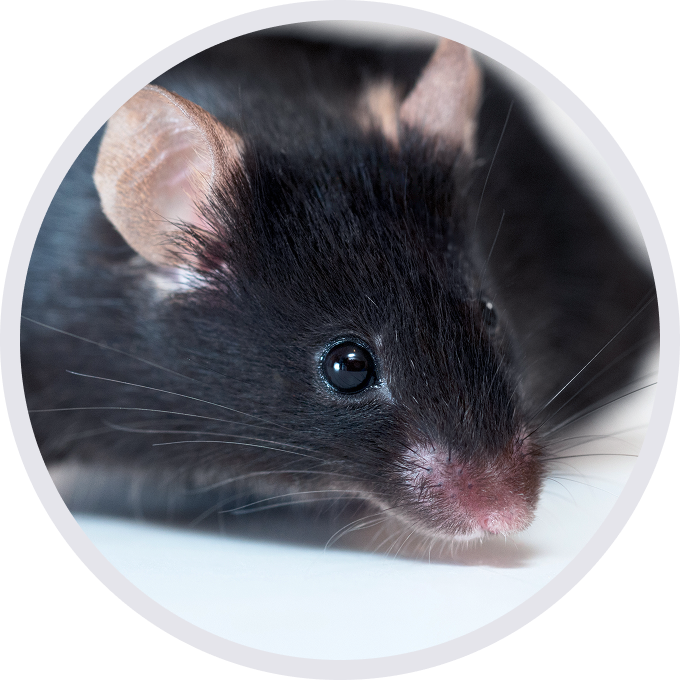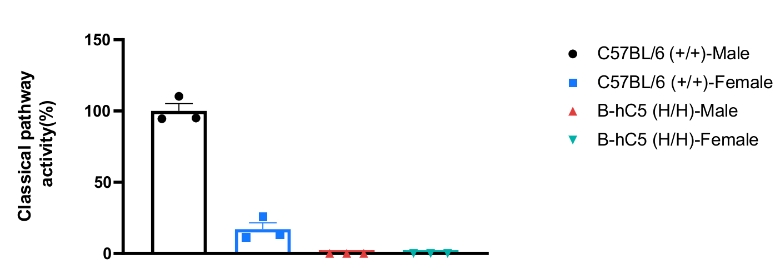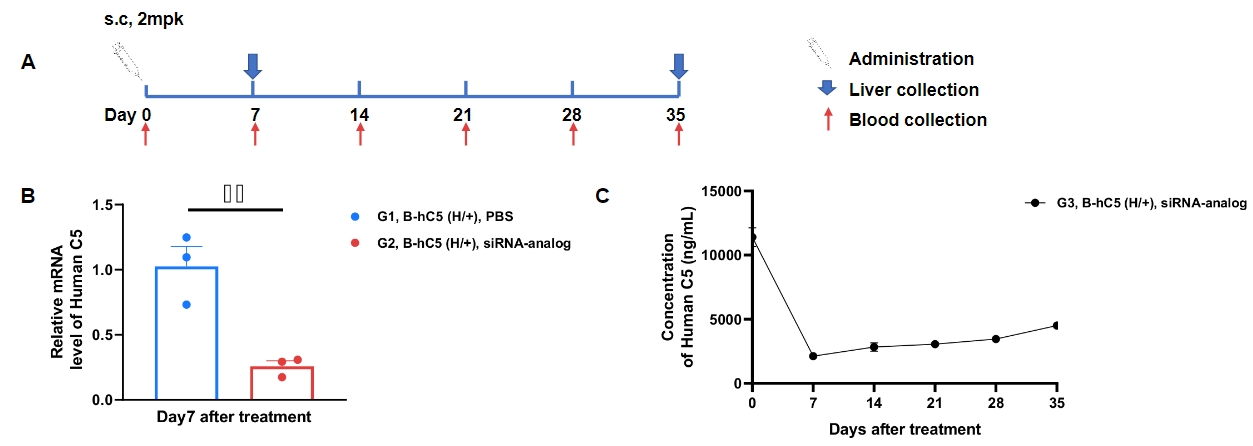
C57BL/6N-Hctm1(C5)Bcgen/Bcgen • 110958
Gene targeting strategy for B-hC5 mice. The CDS of the human C5 gene (excluding exon 1 and part of exon 2) and the mouse 3’UTR were inserted into the exon 2 of the mouse Hc gene in B-hC5 mice. The promoter, 5’UTR, and 3’UTR region of the mouse gene were also retained. The chimeric human C5 expression was driven by endogenous mouse Hc promoter, while mouse Hc gene transcription and translation will be disrupted.

Strain-specific C5 expression analysis in wild-type C57BL/6 mice and homozygous B-hC5 mice by ELISA. Serum was collected from wild-type C57BL/6 mice (+/+) and homozygous B-hC5 mice (H/H) (female, 8 weeks old, n=3 and male, 8 weeks old, n=3). Expression levels of mouse and human C5 were analyzed by ELISA (anti-mouse C5 ELISA kit: abcam, ab264609; anti-human C5 ELISA kit: abcam, ab125963). Mouse C5 was only detectable in wild-type C57BL/6 mice. Human C5 was exclusively detectable in homozygous B-hC5 mice. Values are expressed as mean ± SEM.

Strain-specific C5a expression analysis in wild-type C57BL/6 mice and homozygous B-hC5 mice by ELISA. Serum was collected from wild-type C57BL/6 mice (+/+) and homozygous B-hC5 mice (H/H) ) (female, 8 weeks old, n=3 and male, 8 weeks old, n=3). Expression levels of mouse and human C5a were analyzed by ELISA (anti-mouse C5a ELISA kit: abcam, ab193718; anti-human C5a ELISA kit: abcam, ab193695). Mouse C5a was only detectable in wild-type C57BL/6 mice. Human C5a was exclusively detectable in homozygous B-hC5 mice. Values are expressed as mean ± SEM.

Classical complement pathway activity. Serum was collected from wild-type C57BL/6 mice (+/+) and homozygous B-hC5 mice (H/H) (female, 8 weeks old, n=3 and male, 8 weeks old, n=3). Classical complement pathway activity assay using ELISA kit (Hycult Biotech, HIT420), the classical complement pathway was deficient in B-hC5 mice. Values are expressed as mean ± SEM. B-hC5 mice cannot initiate the classical complement pathway, so B-hC5 mice cannot be used for disease model establishment.

The inhibitory efficiency of the nucleic acid drugs against human C5 in B-hC5 mice. B-hC5 mice (H/+) were randomly divided into three groups (Female, 6 weeks old). The human C5-targeted nucleic acid drugs (synthesized according to patents) and PBS were administered to the mice individually. The nucleic acid drug was administered in the form of PBS aqueous solution. (A) The schematic diagram of experimental processing. (B) The G1 and G2 mice were sacrificed on day 7, and the liver was collected to detect the mRNA level of human C5 by qPCR. (C) The serum of G3 was collected on D7, 14, 21, 28, and 35 to detect the expression level of human C5 by ELISA. The human C5 in the treatment group was significantly reduced after treatment. Values are expressed as mean ± SEM. Significance was determined by t-test, *p

The inhibitory efficiency of the nucleic acid drugs against human C5 in B-hC5 mice. The human C5-targeted nucleic acid drugs ALN-C5 analog (synthesized according to patents) and PBS were administered to the B-hC5 mice (H/H) (Male, 8 weeks old) individually. The nucleic acid drug was administered in the form of PBS aqueous solution. (A) The schematic diagram of experimental processing. (B) The serum was collected on D-2, 7, 14, 21, 28, 35, 42, and 49 to detect the expression level of human C5 by ELISA. The human C5 in the treatment group was significantly after reduced treatment. Values are expressed as mean ± SEM.